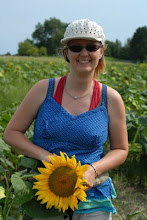Why would you need to keep the milk/lye mixture cool? For one, the heat will change the color of the milk from milky white to bright hunter orange and that color will transfer to the finished soap. So unless you make bright orange soap, the burnt milk will throw off your finished product's color at least a little.
But also, burnt milk means the heat broke down all the good stuff (you know, vitamins, minerals...) that are part of the milk - and which are actually why you want to use milk to begin with. Which means soap made with orange milk/lye is not of as good a quality as soap made with cooled down milk/lye.
How do I keep my milk/lye cool? I measure my milk beforehand (in fluid ounces, as milk is heavier than water) and store it in ziplock baggies in the freezer. Since my recipes are pretty much tailored to my crockpot that means I mostly use 32 fl oz of milk at a time.
When my oil and fat mixture is to temperature, between 100-120 degree F depending on the fats used (some need more heat to melt first and then I place the crockpot directly on the concrete basement floor to cool down) I take out a baggie of milk from the freezer. I run the baggie under a hot tap to release it from the inside, and to create some moisture to start the dilution process. I also use a little bit of water to rinse the milk residue out of the baggie and pour that over the frozen milk, which wets the chunk and gives some starter fluid in the tub to stir (but is not necessary).
I place the chunk of frozen milk in a plastic tub and make sure the outside of the frozen milk is wet (if you let it sit a bit it will freeze up again). Then I sprinkle a layer of lye crystals over the chunk and stir constantly (no splattering!) to prevent any one place from heating up. The heat of the lye will melt the frozen milk, so whenever the lye sluices off I add more crystals. It takes me about 20 minutes in all to slowly but steadily add the lye to the milk and most times only have a little frozen chunk left which will melt on it's own (but keep stirring).
 Do's and don't's of the milk/lye mixture:
Do's and don't's of the milk/lye mixture:- Never let it sit (to heat up or cool down) as the fats of the milk will saponify.
- Keep stirring, as milk does not transfer heat as easily as water; it will build up heat locally and thus burn that area of milk (mixture turns first yellow then orange if you're really not paying attention).
- Add lye crystals steadily but slowly, no sense in hurrying as you have to wait for the frozen milk to completely melt anyway.
If the milk/lye looks off white or slightly green (like whey) the temps are around 80-90 degree F. If the milk is turning pale yellow to yellow it's closer to 90-100 degree F. I have not temped orange milk/lye yet, as that happened once (my first, uninformed, attempt at milk soap) and have tried my all to never have that happen again!
I also started to freeze other liquids like coffee, tea, apple cider, wine etc to be able to make low heat lye mixtures as these liquids also have ingredients like vitamins which you'd like to retain to work for you in your soaps.
The best thing about low heat lye mixtures? Hardly any caustic fumes! I do turn on my (darkroom) fan and wear a gas mask, but that's more for just in case than really needed, seems like.






No comments:
Post a Comment